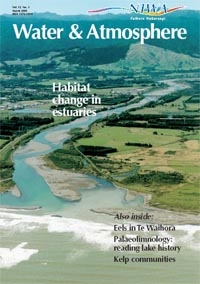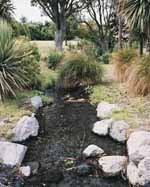PDF of this article (326 KB)

Dave Rowe Joshua Smith Bredna Baillie Mark Meleason
From a fish’s point of view, logging debris in streams can be good or bad. A series of studies is aimed at finding the right balance.
Fallen trees and branches can create pools and backwaters in streams – the perfect home for some native fish. But too much wood can have the opposite effect. It can block small streams completely. In larger streams, wood-debris dams can blow out when the stream floods. The deluge of wood and water can cause much worse stream scouring and habitat destruction than the high flows alone.
Because of this, it is usual practice following tree harvesting to remove all waste wood from streams. However, this can be an arduous, costly and sometimes risky job, and removal of all wood may not be necessary. If the cost of removing waste wood can be reduced and fish populations increased, a win–win situation is created. So what is the right balance? How much wood is good for fish?


Previous articles in Water & Atmosphere have outlined some of the ecological values of wood in streams. (For example, see “Why is wood important in streams?”) Here we examine its role in increasing fish habitat, especially for one of our whitebait species: the banded kokopu.
Why fish need wood in streams
Wood cover helps some fish species hide from predators such as trout and eels, and birds such as herons, kingfishers and shags. However, protection from predators may not be so important for the banded kokopu. This small native fish lives mainly in the pools of small streams (generally less than 2 m wide) flowing beneath native or exotic forest canopies.
In a study of North Island east coast streams prone to flash floods, we found banded kokopu only in pools where there was some form of cover (e.g., an undercut bank, boulder, or wood material). Both fish and bird predators were rare in these small streams. Therefore we concluded that adult banded kokopu depend on instream cover because it protects them from being swept out of their pools by floods.
Banded kokopu juveniles are good climbers, and easily surmount small falls and rapids to get to the first-order tributaries that provide suitable adult habitat. But adults are much heavier and cannot climb or swim well upstream so would probably find it impossible to return to their pools after being swept downstream. This is very important for the maintenance of banded kokopu populations as adult habitat is more limited downstream. If floods continually washed adult banded kokopu downstream, the numbers of breeding adults would be reduced and the population would soon decline. The protection provided by wood and other types of cover in streams may therefore be crucial in protecting banded kokopu from dislodgement during floods.
Stability is important
In another study we examined the importance of wood, as opposed to undercut banks and boulders, for banded kokopu in Coromandel streams. We found that the fish preferred undercut banks, which provide the most stable form of cover. Banded kokopu used wood cover (the least stable form) only when other types of cover were lacking. This implies that the value of wood material in providing banded kokopu habitat is likely to be greatest in streams where there are few boulders and undercut banks.
Of course, the stability of wood debris in a stream will depend on how big the wood is and how easily it might move in a flood. Experiments are therefore needed to determine whether the retention of wood debris in the streams of logged catchments can increase banded kokopu numbers. These need to focus on the larger, more stable pieces of wood rather than on the smaller branches and slash, and look at the placement of such wood in stream reaches where bank and boulder cover are scarce.
Wood is also important for other fish species. Pools are particularly important for inanga (another whitebait species) in lowland streams, and for adult trout in rivers. In a survey of streams in the Nelson area, we found that the number and variety of pools in some streams was determined mainly by the amount of wood present. Follow-up research will examine whether fish species show any preference for particular pool types. The Nelson survey also highlighted the large number of trees suspended across the channel of streams in mature pine plantations. If the trunks are left behind at harvest, they have the potential to improve fish habitat when they fall into the streams.
Too much wood is also a problem
Waste wood is often left in the smallest streams of logged catchments because these streams are unlikely to ever carry flows large enough to sweep the wood downstream. When the forest canopy over small streams is intact, banded kokopu can live in the pools. However logging has two effects that are not good for fish. First, removing the forest canopy results in a decline in banded kokopu, probably because the lack of humidity reduces egg survival and the increased exposure to sunlight affects adult fish. Second, filling the stream channel with wood debris can stop the water flowing freely and reduce oxygen levels. Leaving some vegetation along the stream banks can help with the first problem. The second problem might be solved by a little more creativity with the waste wood.
For example, the fine wood debris could be cleared in some areas and left in others to form small dams. Our observations have shown that small debris dams can greatly increase the abundance of both juvenile and adult banded kokopu. Dams increase water depth and may increase foods for banded kokopu (such as insect larvae and other aquatic invertebrates) and feeding habitat. They can also provide a place for the fish to hide from bird predators. In these small catchments, floods would rarely be big enough to dislodge the dams. So the high densities of banded kokopu supported by such debris-dam pools could well compensate for any loss of banded kokopu from the stream that occurs soon after logging. However, there are still many questions to be answered. What size of pool is required? How far apart should the dams be? How many are needed?
The issue of how much wood is good for fish in streams presents some interesting challenges and potentially useful management outcomes for the forest industry. Trees are clearly vital components of stream ecosystems, whether they grow along the water’s edge or lie fallen in the water. Our research is helping ensure that trees are managed to enhance rather than detract from stream health and native fish biodiversity.
Teachers: this article can be used for NCEA Achievement Standards in Biology (2.5, 2.9, 3.2, 3.4), Science (2.2, 2.3, 3.2). See other curriculum connections at www.niwa.co.nz/pubs/wa/resources
Dave Rowe, Joshua Smith and Mark Meleason are based at NIWA in Hamilton; Brenda Baillie is with Forest Research Ltd in Rotorua.
Further reading
Collier, K.; Baillie, B.; Bowman, E.; Halliday, J.; Quinn, J.; Smith, B. (1997). Is wood in streams a dammed nuisance? Water & Atmosphere 5(3): 17–21.
Meleason, M.; Quinn, J.; Davies-Colley, R. (2002). Why is wood important in streams? Water & Atmosphere 10(3): 18–19.
Rowe, D.K; Smith, J.; Quinn, J.; Boothroyd, I. (2002). Effects of logging with and without riparian buffer strips on native fish abundance, size and community structure in small streams running through a Coromandel pine forest. New Zealand Journal of Marine and Freshwater Research 36: 67–79.
